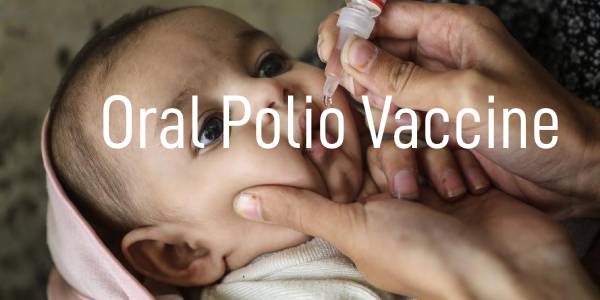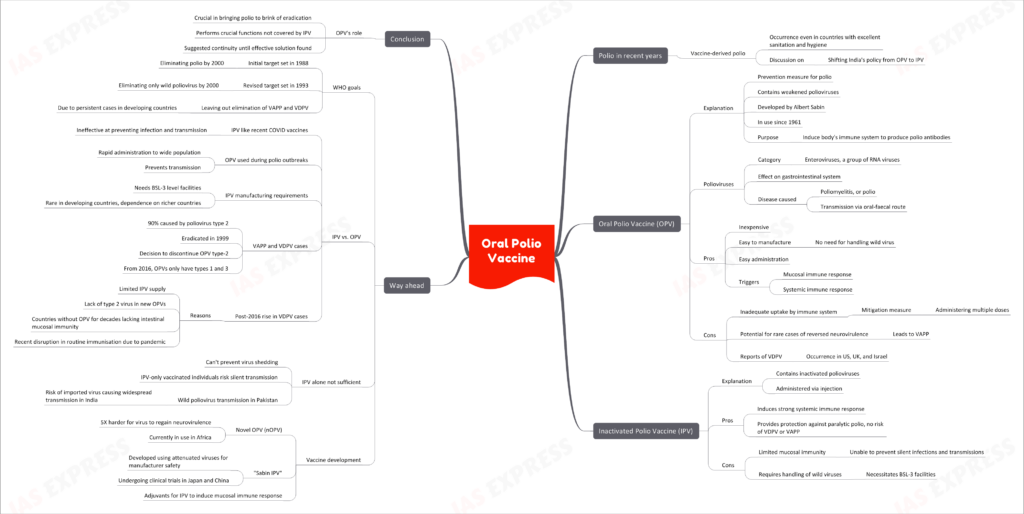Oral Polio Vaccine- Should We Phase it Out?

From Current Affairs Notes for UPSC » Editorials & In-depths » This topic
IAS EXPRESS Vs UPSC Prelims 2024: 85+ questions reflected
In the recent years, even countries with excellent sanitation and hygiene infrastructure are reporting cases of polio, specifically, the vaccine-derived kind. In this light, there have been discussions on whether India should shift away from OPV, in favour of IPV.

What is Oral Polio Vaccine?
- Polioviruses are enteroviruses (a group of RNA viruses) that affect the gastrointestinal system.
- These cause a highly infectious disease called poliomyelitis or polio.
- It is transmitted through the oral-faecal route.
- The oral polio vaccine/ OPV is a way of preventing polio.
- It is a live attenuated vaccine i.e. contains weakened polioviruses of all three types.
- This vaccine was developed by Albert Sabin. It has been in commercial use since 1961.
- The viral strains are weakened to the extent that it remains capable of replicating in the intestine but it cannot cause disease. This helps the body’s immune system to produce antibodies that protect against polio infection.
What are the pros?
- Inexpensive
- Easy to manufacture- the researchers needn’t handle the wild form of the virus at any stage.
- Easy to administer
- Triggers a mucosal immune response in the gut lining. This is like a strong guard at the main gate that prevents the disease as well as person-to-person transmission.
- Additionally, it also provides significant immune response in the blood i.e. systemic immune response.
What are the cons?
- The vaccine’s uptake by the immune system isn’t as good as is desirable, especially in countries like India. To overcome this disadvantage is to administer multiple doses over a time period.
- In rare cases, the OPV can reverse the virus’s neurovirulence. This results in VAPP/ vaccine-associated paralytic poliomyelitis.
- There were reports of VDPV/ vaccine-derived paralytic poliomyelitis in the US, UK and Israel last year. this happens when the virus regains its ability to transmit between people.
Are there any alternatives?
- IPV/ inactivated polio vaccine:
- This vaccine with inactivated polioviruses is administered by injection.
- Pros:
- It induces a strong systemic immune response.
- This provides protection against paralytic poliomyelitis, without the risk of VDPV or VAPP.
- Cons:
- It doesn’t elicit much mucosal immunity. This means that it isn’t able to prevent silent infections and transmissions.
- It also requires the handling of wild viruses that are chemically inactivated. This calls for BSL-3 (biosafety level-3) facilities.
What is the way ahead?
- In 1988, WHO set a target of eliminating polio by 2000. This goalpost was shifted in 1993- eliminating only the wild poliovirus by 2000.
- This meant that eliminating VAPP and VDPV was left out of the global goal. This was because developing countries that were using OPV reported vaccine-derived or vaccine-associated polio cases every year. Meanwhile, developed nations shifted to IPV.
- However, it must be remembered that IPVs are like the recent COVID vaccines, i.e. they aren’t good at preventing infection and transmission. This means that, in event of a polio outbreak, OPV is used (instead of IPV) as it can be administered rapidly to a wide section of the population and can be used to prevent transmission too.
- Also, manufacturing IPV requires BSL-3 level facilities- rarely present in developing countries. Hence these countries have to depend on the richer countries for their IPV supplies. This would limit production and increase the cost.
- 90% of the VAPP and VDPV cases are caused by poliovirus type 2 (a strain that was eradicated in 1999). Hence, it was decided to discontinue the OPV type-2. From April 2016 onwards, the OPVs only have type 1 and 3.
- Notably, the switch to IPV also happened in 2016. Post 2016, the number of VDPV cases hasn’t come down. It has only increased. This is because of several reasons:
- Limited supply/ availability of IPV
- Lack of type 2 virus in new OPVs, leading to circulation of type-2 VDPV
- Countries, like USA, UK and Israel, haven’t been using OPV for decades and hence, their population lacked intestinal mucosal immunity. This aided silent outbreaks of VDPV.
- More recently, disruptions in routine immunisation services due to the pandemic.
- A child vaccinated with only IPV is unlikely to be affected by a paralytic disease, however, he/she still has the risk of being infected and contributing to silent transmission. Hence, we mustn’t be hasty about discontinuing OPV and continuing solely with IPV at this time. It could deprive the population of the protection against virus shedding.
- Also, the transmission of wild poliovirus is still prevalent in Pakistan. If the virus is imported into India, individuals solely vaccinated with IPV could facilitate widespread transmission. This could cause paralytic disease in poorly vaccinated individuals.
- That said, researchers and policymakers have been attempting to address the shortcomings of both the vaccines and eliminate the virus.
- A novel OPV (nOPV) has been developed using attenuated polioviruses with certain genetically engineered mutations that make it 5X harder for the virus to regain its neurovirulence. This is being used in Africa.
- To make IPV safer for manufacturers, researchers are trying to develop it using attenuated viruses, instead of wild viruses. This ‘Sabin IPV’ is undergoing clinical trials in Japan and China.
- Researchers are testing specific adjuvants to make IPV capable of inducing mucosal immune response.
Conclusion:
OPV has been instrumental in helping the world bring a dreaded disease to the brink of eradication. Even though IPV overcomes some of its disadvantages, there are some crucial functions that only OPV is performing for now. Hence, it is unadvisable to skip it before an effective solution is found.
Practice Question for Mains:
Does the recent outbreak of vaccine derived poliomyelitis call for the phase out of oral polio vaccine? Examine. (250 words)
If you like this post, please share your feedback in the comments section below so that we will upload more posts like this.

